Christmas 1949 the BBC made a recording or carols from St. Margaret’s, Tylers Green and Holy Trinity, Penn which was broadcast on the BCC North American Service.
The photograph below was found in the vestry safe, complete with a typed note.

Christmas 1949 the BBC made a recording or carols from St. Margaret’s, Tylers Green and Holy Trinity, Penn which was broadcast on the BCC North American Service.
The photograph below was found in the vestry safe, complete with a typed note.
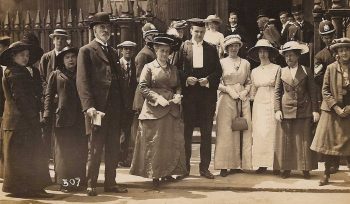 This highly evocative and delightfully informal photograph, taken in the summer of 1913, shows the soon to be Vicar of St. Margaret’s Tylers Green, Gerald Hayward, outside Christ College Cambridge following presentation of his B.A. On his right are his proud parents, William Dunning Hayward and Mary Louise Blackwell Hayward (nee Hansell). His father was from Dorchester, whilst his mother came from North Shields in Northumberland, on his left stands his younger sister Gladys Mary Hayward, at this time the family home was in Broadstairs Kent. He married in May 1917 Dorothy Ellen Phillips who also came from the Kent town. There were no children.
This highly evocative and delightfully informal photograph, taken in the summer of 1913, shows the soon to be Vicar of St. Margaret’s Tylers Green, Gerald Hayward, outside Christ College Cambridge following presentation of his B.A. On his right are his proud parents, William Dunning Hayward and Mary Louise Blackwell Hayward (nee Hansell). His father was from Dorchester, whilst his mother came from North Shields in Northumberland, on his left stands his younger sister Gladys Mary Hayward, at this time the family home was in Broadstairs Kent. He married in May 1917 Dorothy Ellen Phillips who also came from the Kent town. There were no children.
He was born in May 1891 in Croydon, where his father ran a printing and publishing business and after a successful academic career, which also saw him obtain an M.A. in 1917, he became Curate at Christ Church Croydon, before holding the living at Christ Church Chelsea from 1915 until 1918. He saw service in the Great War as a Senior Chaplain to the Forces and in August 1918 was presented by Earl Howe with the living of St. Margaret’s, his annual income however was less than £300.
So began his 33 year tenure as the 6th Vicar of Tylers Green, during which time he saw to the spiritual needs of many of the local inhabitants, however he was just a spectator in 1919 at what must have been the largest funeral then seen at St.Margarets, following the death of the second Sir Philip Rose, by this time Sir Philip had converted to Catholicism and his funeral took the form of a Requiem Mass held in the chapel at Rayners followed by internment in the family vault at St. Margaret’s, Priests from local Catholic churches including St Augustine’s on Amersham Hill presided at the service. It appears that not all his services took place in Tylers Green, as in 1929 he attended the funeral of the 4th Earl Howe in Holy Trinity Penn Street and in 1932 he played a part together with the then Vicar of Holy Trinity Penn, the Rev E Smith, in the funeral service of Sir Donald MacLean. However, one of his more intriguing marriage services was when he officiated at the wedding of one Edgar Whyte better known as “Eddie Steele” when he married in St Marys Appledram Kent in 1939. The Southern Area Heavyweight Boxing Champion had fought Tommy Farr among others.
The fabric of the Church continued to change during Gerald Hayward’s incumbency, new vestries were installed in 1922, an extension to the Chancel and a new east window in 1932, the pews were cleaned in 1934 and the oak doors were added in 1935.
Gerald Hayward died suddenly at his home in Tylers Green on Sunday 12th August 1951 aged just 60. He had conducted the morning services at St Margaret’s, but complained of feeling unwell during the afternoon and died a few hours later. After a Memorial Service at St Margaret’s on Wednesday 15th August a cremation took place at Woking Surrey. He was survived by his widow Dorothy who died in Penn in 1973.
Many thanks to Edna Viner, Miles Green and Eddie Morton for their assistance in researching this article and photographs. The photographs here and on our front cover are reproduced courtesy of Mrs Liz Tebbutt and Chepping Wycombe Parish Council.
Village Voice, No.91 June/July 2002
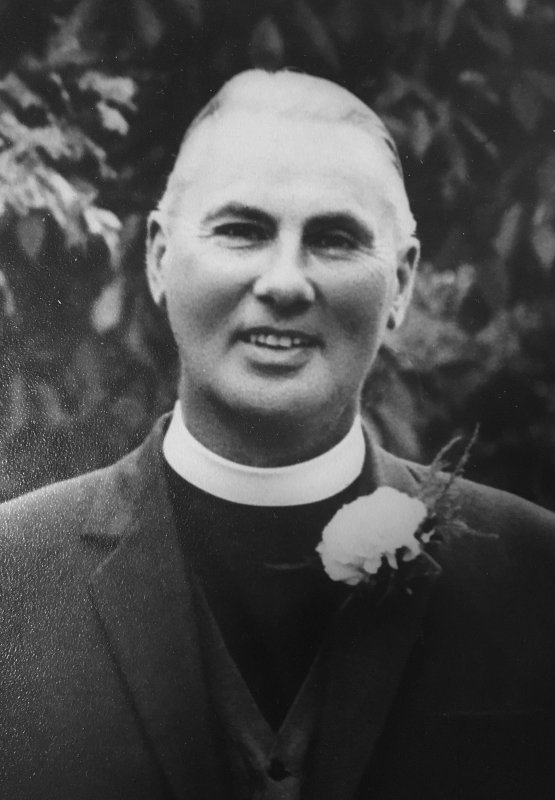 John Kenneth Siderfin was born 5th October 1905, at Nether Compton in Dorset, with an older brother Hugh. Their mother died when John was 10 years old.
John Kenneth Siderfin was born 5th October 1905, at Nether Compton in Dorset, with an older brother Hugh. Their mother died when John was 10 years old.
The family moved to North London, and John was educated at the Stationer’s Company School.
John and Grace Castle were married 27th April 1929 at St. Marks, Tollington, Islington, and then lived at Pitsea Essex. They had two children, David 1931 and Stephen. 1932.
John worked initially for the LNER at Stratford, East London. The family moved to Chesham in 1940, and John was ‘called up’ in 1942.
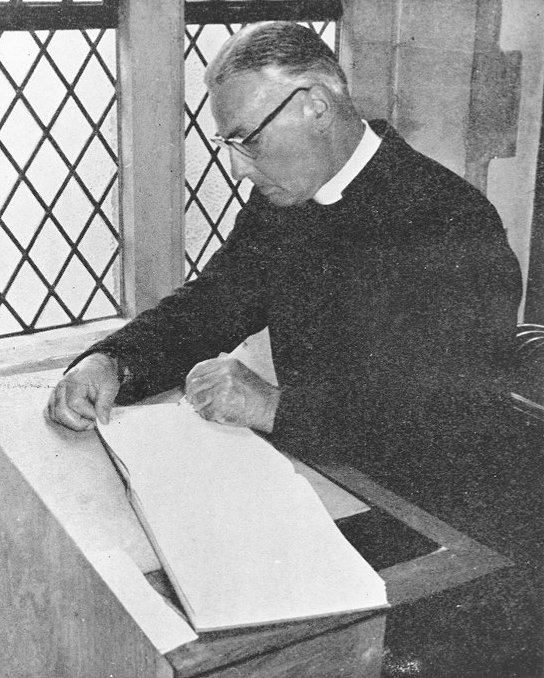
After he was demobbed, John studied at London College of Divinity, at Northwood, and was ordained deacon in 1948. He served his curacy at St. Paul’s in Slough and was ordained priest in 1949, and appointed as a curate to St. Mary’s, Beaconsfield.
Following the sudden death of the Rev. Gerald Hayward on Sunday 12th August 1951, aged just 60, John was appointed vicar of St. Margaret’s in January, 1952. Amongst other things, he helped to revive scouting in the village, soon becoming the new scoutmaster. (Picture: St Margaret’s)
John Siderfin died in office of a pulmonary embolism, 20th September 1966, also aged 60. His ashes are buried at Nether Compton. He is also remembered on his wife Grace’s memorial stone in Cock Lane cemetery, Tylers Green, on the left part way down.
Thanks to Steve Siderfin and Peter Stapleton for these notes.
The original St. Margaret’s graveyard was extended in 1902 and again in 1952 when Chepping Wycombe Parish Council, who are now the burial authority, purchased part of the remaining Vicarage meadow, behind the Vicarage, for an addition to the Churchyard which by then was completely full.
The new extension was opened by the Bishop of Buckingham, Robert MIlton Hay in 1953.
Bishop Hay is on the left and the vicar of Tylers Green, Revd. John Siderfin on the right, with the choir and church-wardens.
St Margaret’s churchyard was formally/legally closed by Revd. Michael Hall and so the new graveyard extension is no longer the responsibility of the church but of Chepping Wycombe Parish Council. The 1953 extension in its turn, is almost full and a site for a new cemetery was purchased by Chepping Wycombe Parish Council in 1968 at the top of Cock Lane, below the CWPC parish offices, and the first interment took place there in 1995.
The photograph below was published in Miles Green’s book The History of St. Margaret’s Tylers Green on this website and is repeated here as part of the history of vicars from 1854 to date.
It includes the bishop of Buckingham and a group of local clergy.
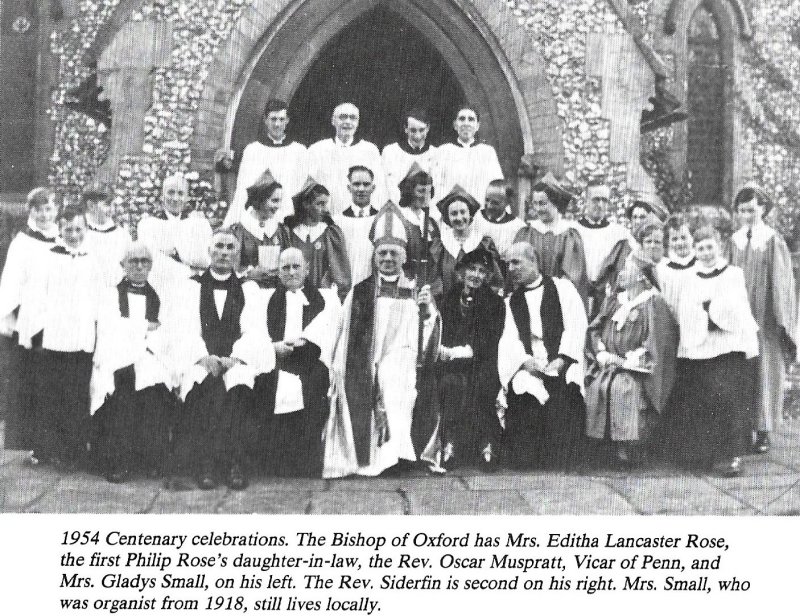 St Margaret’s, Tylers Green, Centenary Celebrations, October 1954
St Margaret’s, Tylers Green, Centenary Celebrations, October 1954
Back Row: Peter Stapleton, Jack Hemuss, Terry Hemuss, Ron Blaxter
Middle Row: Stuart Harley, Brain Hemuss, Geoffrey Palmer, ??, Pat Tomlinson, Barbara Barnes, Ernie Witney, Pat Stapleton, Elizabeth Small, Ernie Trendall,
Hilda Hemuss, Harry Holmes, Mrs Holmes (Organist), Nelly Hughes (Mrs Lancaster Rose’s housekeeper), Don Butler, ??, Jean Rolfe
Front Row: Revd Houlday, Revd Siderfin (St Margaret’s), ??, The Bishop of Buckingham Revd. Robert Hay, Mrs Editha Lancaster Rose, Revd Oscar Muspratt (HT Penn), Mrs Small, Choirmaster & Organist.
(Thanks to Peter Stapleton for identifying the people in the photograph)
View image as a PDF which can be enlarged (PDF opens in new window)
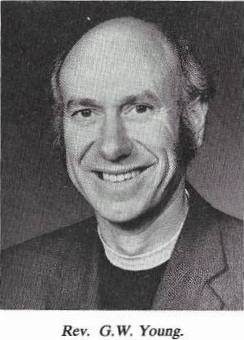
Revd. George Young was vicar of St. Margaret’s Tylers Green for 13 ½ years, from 1967 until 1980. He took his final Communion at St. Margarets on Sunday 26th October 1980. George Young was very involved in the life and activities of the local community. he was Chairman of Tylers Green Middle and First School Management committees, Vice Chairman of Manor Farm Schools, Vice Chairman of Rayners School Governors and on the governing body of Sir William Ramsay School. He was also a Councillor on Chepping Wycombe Parish Council and on Wycombe District Council, when it was Wycombe Rural District Council. Chairman of the Parochial Church Council at St Margarets and on the Group Executive committee of the 26th Penn & Tylers Green scout troop, as treasurer,
Village Voice 78, April/May 2000
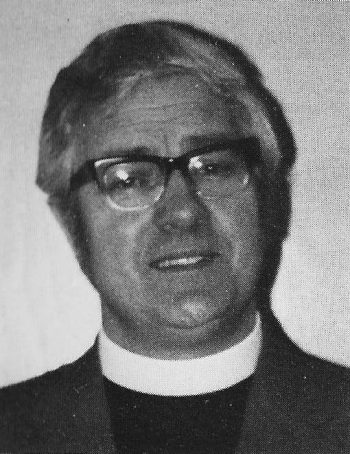 Tylers Green will be without a regular vicar for some time following the retirement of the vicar of St Margaret’s, the Rev Michael Hall, in April. A spokesman for the Wycombe Deanery said retirements and departures were due in a number of Wycombe area churches, as well as neighbouring parishes, in the next couple of years so the church would use the opportunity to review the overall position and listen to the views of parishioners.
Tylers Green will be without a regular vicar for some time following the retirement of the vicar of St Margaret’s, the Rev Michael Hall, in April. A spokesman for the Wycombe Deanery said retirements and departures were due in a number of Wycombe area churches, as well as neighbouring parishes, in the next couple of years so the church would use the opportunity to review the overall position and listen to the views of parishioners.
An interregnum – an interval between the departure of one person and the arrival of another – is usual in the church once a vicar leaves a parish. The Deanery spokesman said that over the years the make-up of parishes in and around the Wycombe area had changed and populations had shifted. Some churches were now busier than others so the time seemed right to review the general position.
Both the Rev Nigel Stowe, the vicar of Penn Street and Holmer Green; and the Rev Carol Williams, the vicar of Penn (both areas are not in the Wycombe Deanery) are due to leave in about two years due to retirement and end of contract respectively. If any changes to personnel or church boundaries are to be considered it could therefore be a number of years before the Bishop of Oxford makes a final decision.
In the meantime a locum is likely to oversee church affairs at St Margaret’s following the Rev Hall’s retirement in 2000 he moved to Cornwall with his wife Joyce. He had been vicar at St Margaret’s for nearly 20 years and during his tenure he oversaw the extension and modernisation of the Parish Rooms.
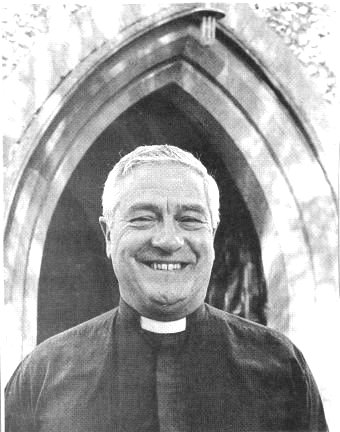 Never one to shirk controversy, he and his parochial church council fought strong campaigns against the ordination of women and the liberalisation of homosexuality issues. In 1996 St Margaret’s applied for oversight by a “flying” bishop because of its opposition to women priests; and in 1998 the Rev Hall and the PCC told the Archbishop of Canterbury that St Margaret’s no longer accepted the authority of the Bishop of Oxford as its diocesan bishop because of the bishop’s “liberal statements”. St Margaret’s refused to pay its quota payments – the amount a parish pays to the diocese to cover costs such as salaries and administration – for a number of years. There have also been legal battles highlighted in the national press and some lively exchanges with village organisations, including Chepping Wycombe Parish Council and the Residents’ Association. The congregation also raised many hundreds of pounds for various overseas missions during the Rev Hall’s tenure.
Never one to shirk controversy, he and his parochial church council fought strong campaigns against the ordination of women and the liberalisation of homosexuality issues. In 1996 St Margaret’s applied for oversight by a “flying” bishop because of its opposition to women priests; and in 1998 the Rev Hall and the PCC told the Archbishop of Canterbury that St Margaret’s no longer accepted the authority of the Bishop of Oxford as its diocesan bishop because of the bishop’s “liberal statements”. St Margaret’s refused to pay its quota payments – the amount a parish pays to the diocese to cover costs such as salaries and administration – for a number of years. There have also been legal battles highlighted in the national press and some lively exchanges with village organisations, including Chepping Wycombe Parish Council and the Residents’ Association. The congregation also raised many hundreds of pounds for various overseas missions during the Rev Hall’s tenure.
Village Voice 78, April/May 2000
Following a 3 year interregnum at St Margaret’s, Rev. Mike Bissett was appointed vicar in 2003, with joint responsibilty for Holy Trinity, Penn.
Michael Hall died June 2021 aged 88.
Mike Bisset has lived in the village since his appointment as Vicar to Holy Trinity & St Margaret’s Churches in 2003) and now 19 years later; we must say Goodbye as he retires. Mike has been an enthusiastic contributor to) and supporter of community life.
Tell us a bit about your early life
I was born in West London and grew up there very happily with my parents and sister. After A levels I would have studied Physics and Sheffield, but decided that I had had enough of education and wanted to earn some money. So I joined the Ministry of Defence as a Civil Servant and commenced my career working in various London Offices. I enjoyed my time in the MoD and worked with some excellent people and loved working in London. I met and married my wife Alison and we moved to Harrow where we stayed for 18 very happy years as our family grew. God, however, had plans for me and after 22 years in the Ministry of Defence, three years at Theological College and four years as a curate in Ickenham, Ali and I and our three teenage children arrived in the Vicarage in Penn in July 2003. Our two sons, Chris and James, started at Dr Challoner’s Boys School and our daughter, Suzy, at Dr Challoner’s Girls school in the September.
Clerical attire
My involvement in church life in many ways since a teenager and then four years’ curacy had prepared me for the functions of a Vicar. You have ~ image of yourself, tucked away in a dimly lit study, late at night, surrounded by thick dusty books, crafting your latest sermon. A comforting image for an introvert. So, it is a shock when you find yourself, as I did the other week, shouting over 30 excitable children from the First School asking them what they think a vicar does. Being a vicar is nothing like what you expect. Services and sermons occupy a small proportion of my time. Managing an organisation (which is what the church is) through the huge volume of administration (via email) are the things that are essential but, for me, time consuming and draining. Visiting people, helping folk through the trauma of death and a funeral, working through marriage prep with a young couple, taking school assemblies, working with others to set up for ‘one off’ events are the things that energise me.
‘Structures’
In the MoD, life is nicely structured with clear job boundaries, set times and structures. Those boundaries and structures all disappear when ‘working from home’. It is important for me to have some structure and so I attempt to put this into the week by setting times for dealing with emails, afternoons for visiting, certain days for preparing for Sundays, and administration. Of course, inevitably, a phone call will disrupt those nicely-laid plans.
The work is extremely varied and does defy job descriptions and time sheets. I have frequently been heard to utter the words ‘they do not tell you about that in Theological College’. One not untypical experience was in the second year of my curacy when one Saturday I took the funeral of an 18 month old child in the morning, a wedding in the afternoon and ran an event for the youth in the evening.
What excites me?
Of the things that I have done here in the Parishes it is work with children and teenagers that I have enjoyed the most. It almost feels as though one absorbs energy from the children. It is also the hardest thing I do. With adults one can be vague and waffly, hoping to pass it off as being profound, but with children you have to be short, clear and visual (little of that at Theological College).
I have probably taken the most satisfaction from the ‘Songs of Praise on the Common’ services that we have run. They signify the church escaping the building and singing God’s praises, in the open air, in the heart of the Community. That has been something special. I am grateful to Her Majesty for providing me with the opportunity for my last public act to be the service on the Common on 5th June.
When I arrived, both Holy Trinity and St Margaret’s were recovering from some traumatic times and it has been lovely to see the grace of God at work in healing within the churches and also bringing them together.
One word to describe your time here?
Privilege. It has been a huge privilege to be permitted to be in the midst of families and alongside individuals at those most profound moments in life of birth, marriage and bereavement. Listening to people’s stories is always a profound and humbling experience as they open their hearts, often with tears, in sharing themselves. They are sacred moments.
The Church and the World
I have been most grateful for the work of the P&TG Residents’ Society here. I remember at Theological College hearing Rowan Williams (then Archbishop of Canterbury) speaking about community itself being a divine thing; just the act of diverse people getting together was pleasing to God. The Residents’ Society does an amazing job in generating and maintaining community and wherever possible I have sought to support that. It is a very hard thing to create and we must not lose it here.
What next?
Our children have now all left home and so Ali and I will initially move to our house in Ealing. We have got used to village life and plan to head out this way in due course. I am very much looking forward to more boating, more quality ‘garage time’ and catching up with mends and relatives. We also have a few holidays lined up.
Who will replace you as Vicar?
The job here will be advertised in the press, applicants shortlisted and interviewed. All of that takes the best part of a year. The parishes here will attract good candidates. And if my successor comes to know the love and grace that I have come to know here, they will be truly blessed. Being a vicar is not a job, it is a life. The amazing people of Penn & Tylers Green are a part of me and I will remember you always, tell stories about you at dinner parties and pray for you. Thank you, thank you.
Village Voice June/July 2022